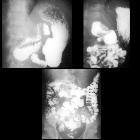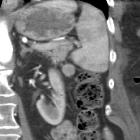Polysplenie-Syndrom
Polysplenia syndrome, also known as left isomerism, is a type of heterotaxy syndrome where there are multiple spleens congenitally as part of left-sided isomerism.
Epidemiology
Polysplenia is seen predominantly in female patients. It is usually diagnosed in childhood or adulthood, later than asplenia syndrome, since associated congenital heart diseases tend to be less severe than those encountered in the latter.
Etiology
The exact cause of polysplenia is unknown. However it is suggested that it is caused by various factors :
- embryogenic
- genetic
- teratogenic
Clinical manifestation
Clinical presentation is related to the associated pathology.
Pathology
Polysplenia results from failure of development of the usual left-right asymmetry of organs and consists of situs ambiguus, with features of bilateral left-sidedness.
Radiographic features
General
It is characterized by multiple splenules without a parent spleen. It occurs on the patient’s left side but may be bilateral. The most common associated feature is inferior vena cava interruption with azygos or hemiazygos continuation .
Other characteristic features include:
- bilateral hyparterial bronchi
- bilateral bilobed lungs
- bilateral pulmonary/left atria
- midline liver
Associations
- congenital heart disease (>50%): especially non-cyanotic, and less complex/severe than in asplenia syndrome
- abnormal pulmonary venous return (70%, PAPVR/TAPVR)
- dextrocardia (37%)
- gastrointestinal
- semi-annular pancreas / congenitally short pancreas
- midgut malrotation (80%)
- gallbladder agenesis (50%) and biliary atresia
- mobile cecum
- tracheo-esophageal fistula
- genitourinary
- vascular
- inferior vena cava anomalies
- intrahepatic IVC interruption with azygos/hemiazygos continuation
- portal vein anomalies
- inferior vena cava anomalies
See also
Siehe auch:
- Azygoskontinuität
- Lungenvenenfehlmündung
- Nebenmilz
- intestinale Malrotation
- Herzfehler
- Splenose
- Pancreas anulare
- Situs ambiguus
- einseitige Nierenagenesie
- situs classification
- mobile cecum
- Gallengangatresie
- fokale Milzläsionen und Anomalien
- angeborene ösophagotracheale Fistel
- congenitally short pancreas
- asplenia/polysplenia
- Gallenblasenagenesie
und weiter:
 Assoziationen und Differentialdiagnosen zu Polysplenie-Syndrom:
Assoziationen und Differentialdiagnosen zu Polysplenie-Syndrom:














